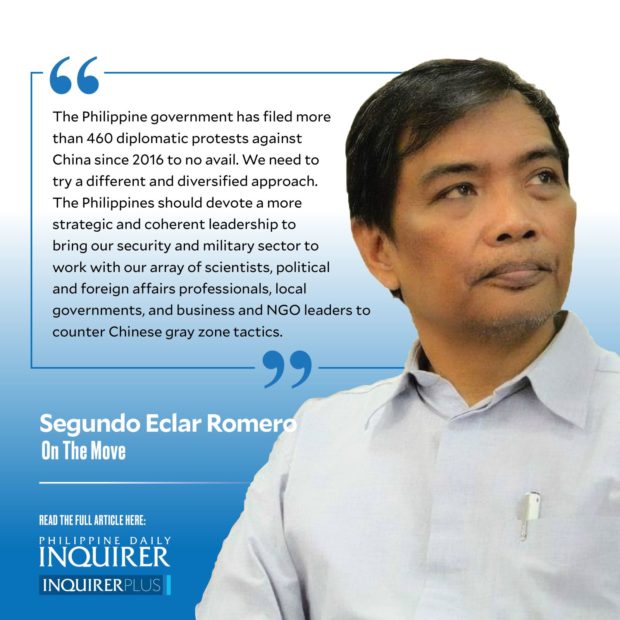Confronting China’s ‘gray zone’ tactics

This aggressive Chinese posture is not new and can no longer be denied. In August 2022, Philippine Coast Guard RAdm. Armando Balilo said Chinese Coast Guard vessel 5205 prevented PCG’s BRP Teresa Magbanua (MRRV-9701) from delivering supplies to the BRP Sierra Madre. The CCG crew uncovered their 70 mm weapons and blockaded the PCG ship with CCG 5102 and two Chinese maritime militia. Pointing a laser is also a hostile act, acquiring or “painting” a target, a potential prelude to live fire.
The Chinese will continue using gray zone tactics. These refer to acts of confrontation and conflict to achieve political objectives that arguably fall below the threshold of armed conflict. They refer usually to nonmilitary means, including electoral meddling, social media and cyberattacks, verbal warnings and confrontation, and physical intimidation and coercion, including the use of military-grade lasers.
Article continues after this advertisementChina is a bully prowling the world, flashing and poking with laser weapons against big and small nations alike. Chinese laser attacks have been used by a Chinese PLA vessel against an Australian air force plan in February 2022. Multiple laser incidents were cited by the US air force from China’s military base in Djibouti.
Gray zone tactics are part of China’s cabbage strategy, incrementally peeling off the resolve and physical stamina of opposing forces, like starving the crew of the BRP Sierra Madre to death by preventing resupply missions to reach them.
The use of lasers, particularly, is specifically proscribed by the Protocol on Blinding Laser Weapons (Protocol IV to the 1980 Convention). However, China’s claim that the use of the laser by the CCG was for “navigation” and “maritime order” only suggests their excuse will be that the temporary blinding of PCG crews was only “incidental” to the primary purpose, an exception written into the Protocol.
Article continues after this advertisementBen Nimo, a UK-based analyst and writer on European security issues, writing in 2015, tells us that the Russian takeover of Crimea in 2014 is an outstanding example of gray zone tactics. We now see in hindsight that the Russian success in snatching Crimea had emboldened Russia to invade Ukraine in February 2022. The urgent lessons from the Crimean takeover slipped the US and Nato. Meantime, the Taiwan flashpoint in Asia is a mirror of the Ukrainian situation that requires anticipatory active defense.
Nimo’s characterization of Russia’s gray zone tactics uncannily applies to Chinese gray zone tactics toward the Philippines. Nimo unpacks several tools in this gray zone toolbox:
1. Distort – Twist facts, make up evidence, and sell a fake version of reality.
2. Dismiss – Undermine, denigrate, and insult opponents and critics.
3. Distract – Turn the people’s attention away to other countries’ own detrimental actions.
4. Dismay – Terrify the target audience with their own helplessness.
5. Delay detection – Delay how long it takes the victim’s surveillance and reconnaissance systems to work out what is going on.
6. Delay attribution – Delay the victim’s identification of who is responsible.
7. Delay decision – Delay how decision-makers work out a decision acceptable to all.
8. Delay reaction – Delay how long it takes to take action against the aggressor.
According to the Rand Corporation, China has employed nearly 80 different gray zone tactics across all instruments of national power against Taiwan, Japan, Vietnam, India, and the Philippines in the past decade.
The Philippine government has filed more than 460 diplomatic protests against China since 2016 to no avail. We need to try a different and diversified approach. The Philippines should devote a more strategic and coherent leadership to bring our security and military sector to work with our array of scientists, political and foreign affairs professionals, local governments, and business and nongovernment organization leaders to counter Chinese gray zone tactics.
The reinvigorated alliance with the United States casts a wide net of opportunity and support to work more closely with Japan, South Korea, Australia, and India. We should also strengthen our relations with the international community, uphold the rules-based international law, and continuously and unabashedly take the side of Ukraine and other victims of aggression.















